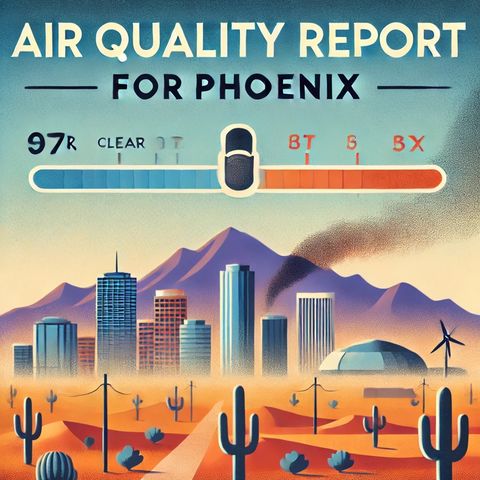Phoenix Faces Moderate to Unhealthy Air Quality Levels Due to Ozone, Particulate Matter, and Weather Conditions

Descarga y escucha en cualquier lugar
Descarga tus episodios favoritos y disfrútalos, ¡dondequiera que estés! Regístrate o inicia sesión ahora para acceder a la escucha sin conexión.
Descripción
As of today, Phoenix, Arizona, is experiencing air quality levels that require attention, particularly for sensitive groups such as children, the elderly, and those with preexisting respiratory conditions. The city's...
mostra másOzone pollution in Phoenix tends to be most pronounced during the warmer months, but current weather patterns are elongating this effect into fall. Ground-level ozone is formed when pollutants emitted by cars, power plants, and other industrial sources chemically react in the presence of sunlight. In Phoenix, these conditions can be exacerbated by temperature inversions, where warm air traps pollutants close to the ground, reducing air movement and dilution. As a result, individuals with asthma or other respiratory problems should limit outdoor exertion during high ozone days.
Particulate matter, or PM, is another significant contributor to air quality concerns in Phoenix today. This mixture of tiny particles and liquid droplets includes acids, organic chemicals, metals, and soil or dust particles. Phoenix’s arid environment naturally produces dust, but human activities like construction, road dust, and fossil fuel combustion significantly increase its concentration. Elevated levels of PM can penetrate deep into the lungs and even enter the bloodstream, causing cardiovascular and respiratory issues.
Weather patterns play a crucial role in managing air quality. On days with little wind or atmospheric changes, pollutants linger longer, worsening air quality. Phoenix's current climate conditions, which include stagnant air and minimal precipitation, limit the natural dispersion and removal of airborne pollutants. These conditions are not uncommon for the region and highlight the ongoing challenge of managing urban air quality in an expansive metropolitan area surrounded by desert.
To improve air quality, local government agencies are actively monitoring pollution levels and promoting measures designed to reduce emissions. Public transit initiatives, encouragement of carpooling, and regulations aimed at industrial emissions are some strategies employed to tackle pollution sources. Residents are advised to stay informed about daily air quality levels through resources like the Environmental Protection Agency's AirNow website and local air quality alerts.
In response to today's challenging air quality conditions, residents of Phoenix are urged to minimize outdoor activities, especially during the afternoon when ozone levels typically peak, and to use air purifiers indoors to reduce exposure to particulate matter. Additionally, exercising outdoors should be done in the early morning or after sunset, when air quality generally improves. By taking these precautions, residents can help protect their health while local authorities continue efforts to enhance the region's air quality.
Información
| Autor | QP-5 |
| Organización | William Corbin |
| Página web | - |
| Etiquetas |
Copyright 2024 - Spreaker Inc. an iHeartMedia Company
